All Things koi and H2O
Give it a shot
Duncan Griffiths
Introduction
This short
article is to give an insight into the possible injection sites and some of
the more popular injection methods for koi.
There are
three main ways to inject an antibiotic
IM, intramuscularly
IP, Intraperitoneally
IV, Intravenous
We will
take the last first, IV, Intravenous,
IV, Intravenous
as the name implies involves delivering the medication into a vein of the
fish, this involves an injection site under the caudal peduncle just ahead
of the caudal fin.
The main vein run directly under the spinal column, so the needle is inserted
vertically at this point until it comes up under the spine and actually very
lightly hits the spine, at this point the syringe is withdrawn away from the
spine a very minute distance about 1ml the actual point of the syringe should
now be in the vein.
A slight
pull back on the syringe plunger should draw blood into the main body of the
syringe, this is an indicator that you are in the exact spot needed and at
this point you should depress the plunger and deliver the medication.
It has to
be mentioned this is not a well-practised protocol for many reasons all of
which should be apparent, and is not recommended for the amateur fish fixer.
- Small fishes do not adept well to
this method
- Possible Damage to the spine
- a possibility of a severed vein
- A very definite need to anaesthetise
the koi
- Not a very easy technique to master
x
marks the spot for an Intravenous injection
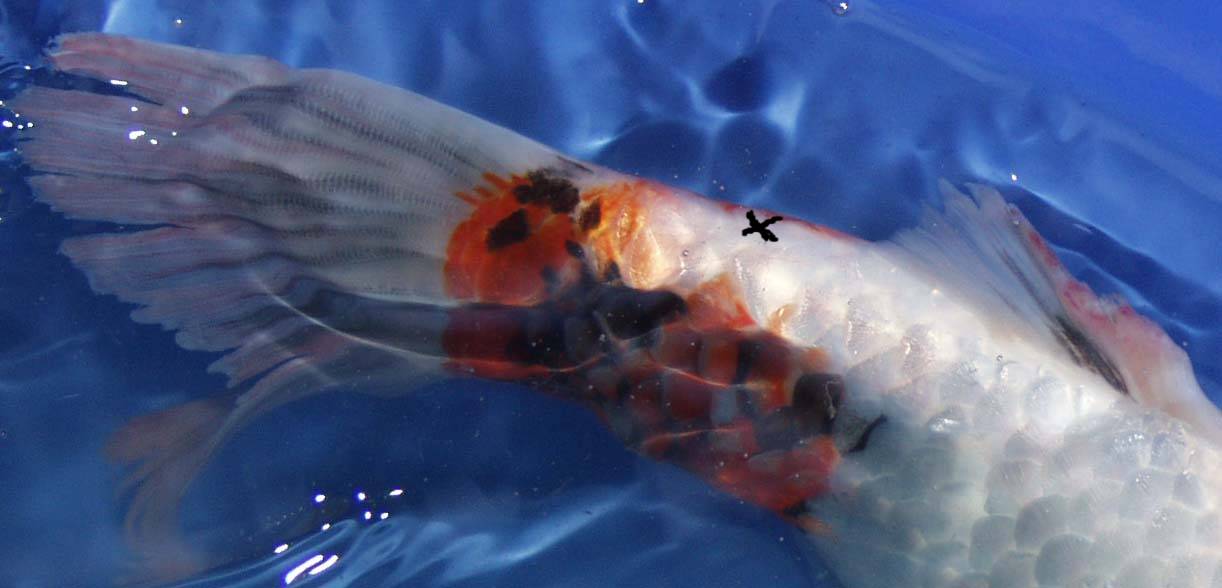
This leaves two methods for our purpose IM and IP
There is
much debate over these two mainstream methods of injecting, which type is
better and more effective than the other.
IP is considered
the better method in the USA, where as IM is by far the common practice in
the UK.
There is
only one site for an intraperitoneal injections, that is midway between the
anal fin and the ventral fins and further involves turning the koi upside
down, so more often than not anaesthetic is involved, in order to avoid handling
damage and needle damage if the koi were to move whilst the injection process
is taking place.
IP or intraperitoneal
injections involve delivering the antibiotic injection into the stomach cavity
of the fish, there it is absorbed into the blood stream very quickly indeed,
this is said to be a more effective way to deliver the medication over IM
injections. There may be some element of truth to this, but this is to do
with the way the koiís blood circulation works.
IM or intramuscular
injections given into the muscle, the substance ie,antibiotics given this
way diffuses into the tissue and then into the blood stream, then the circulation
of the substance begins, trouble with this is, antibiotics circulating in
this way have to go through the kidney, which in itself is a sieve for impurities
and as the antibiotic itself is an impurity the kidney may purge some of its
usefulness out of the blood stream to waste.
IP injections given into the stomach cavity and diffusing into the blood stream
do not go this route through the kidney, with obvious benefits
But its
not all good news for IP injections, as there is an abundant flora of beneficial
bacteria living in the koiís gut that aid digestion, the first port of call
to an injected substance given the IP route is the gut and this self same
bacteria. We cannot afford to destroy these beneficial digestive bacteria.
Additionally
with IP injections, there is a slight risk of damage to a major organ or a
puncture to the intestine with fatal consequences
However,for
those who, practice IP injections, such occasions are very rare.
Technique
Anaesthetise
the koi once the koi is calm, turn it upside down, this has the effect of
allowing the internal organs to drop down in the stomach cavity in the direction
of the spinal column, thus out of the way of the impending intrusion of the
syringe needle.
Draw and imaginary line between the vent and the ventral fin,down the centre
line of the fish
Pick a spot
midway between these two points and begin to place the needle, at this point
before inserting the syringe in to the abdomen, move the needle about 2 ml
off the centre line, this avoids a very hard piece of cartilage running dead
centre, either side of centre line is OK, pointing the syringe forward at
a very shallow angle, as thought, if the needle were long enough it would
emerge out of the koiís mouth. insert the needle keeping the needle running
just under the skin, once most of the needle is inserted try a depress the
syringe plunger down if resistance is met push the needle in a little further
till the plunger moves easily† and
fluid runs out. If resistance is still encountered, back the needle out a
little then very slightly increase the angle of the injection, but not to
much and try again.
T his type of inject is unlike IM injections, when the right spot is obtained
the fluid in the syringe will move out into the abdomen with little or no
resistance.
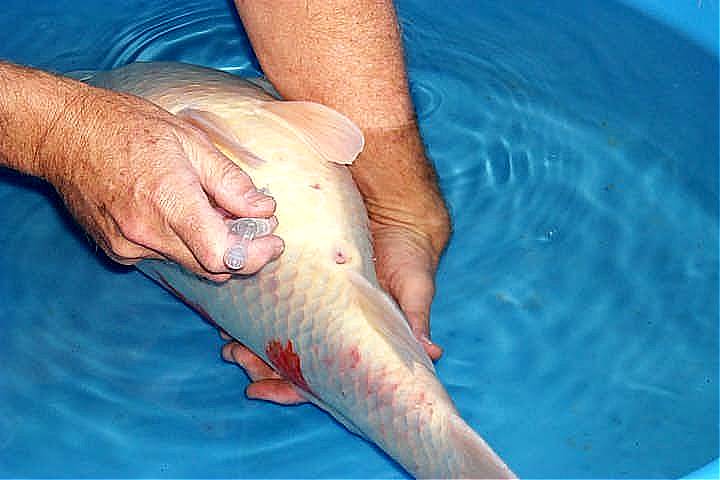
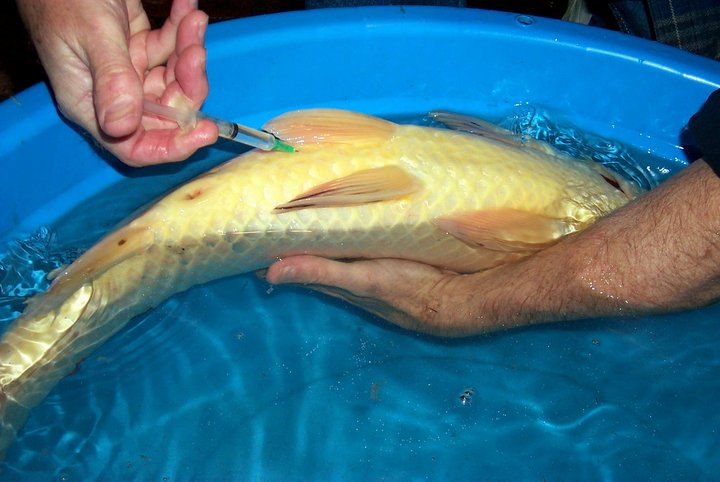
IM, intramuscularly.
There is
virtually no muscle that cannot be injected on a koi but again there are three
main sites with a few less common sites, but in theory there is no end to
the possible sites.
This is
the main protocol for injections in koi in the United Kingdom. Only very few
in the UK do IP injections
The most
common site is the in the tail muscle or caudal peduncle
This starts
at the base of the caudal/tail fin and moves forward to an area just before
the vent region
To pick a point for this type of injection, anaesthetising the koi is preferable.
As the koi
lays on its side count four or five scales from the base of the caudal fin
along the lateral line, at this point go one scale below the lateral line
and slide the needle under a scale (remember only 20% of the full size of
the scale is on show) so if you have 5 ml of scale showing you will need to
travel another 15 ml under the scale before you can attempt to turn the needle
point down into the flesh of the muscle, otherwise you will likely hit a scale
and the injection will not penetrate the tissue
Remember
to massage the area as the injection substance enters the fish, as this is
entering a restrictive muscle area and will expand that area of muscle tissue.
The next
popular site is the dorsal area, pick an area level with the leading ray of
the dorsal fin and move about 5 ml to one side, as the needle enters under
the skin the angle you want again,
is to point the needle as though it were too come out through the fishes mouth,
this type of injection in this area is prone to blowing back some of the antibiotic
because the muscle contracts and pushes the substance back the way it came
once the needle is removed, try sealing the entry point with Ora powder as
the needle comes out
The ball
muscle at the base of the pectoral fin
This is a
very popular site as it does not have any scales and has a very high distribution
capability, via the pectoral girdle
As the description
suggests you insert the needle at the back of the pectoral fin in the ball
muscle whilst the koi is anaesthetised
Recommended
site, but not for large injections, although it is a very good site for low
volume high active ingredient percentage injections
This is
also my preferred site for forward fin, Body, mouth or head & face, infections.
In the case
of mouth rot I have been known to save a little of the total volume to be
injected, about 0.1 ml, and give that right into the upper or lower lip/jaw,
to get things moving
Another
popular site is under the base of the caudal peduncle again in the tail muscle,
this has the distinct advantage of, if an injection related infection sets
in as a result of the injection itself, it will not show a scar, much the
same can be said of the pectoral ball muscle. Although if you have observed
hygiene rules and cleaned the injection site both pre and post injection this
should not arise, it does happen on the odd occasion no matter how hygienic
you are.
Some examples
of IM injection sites
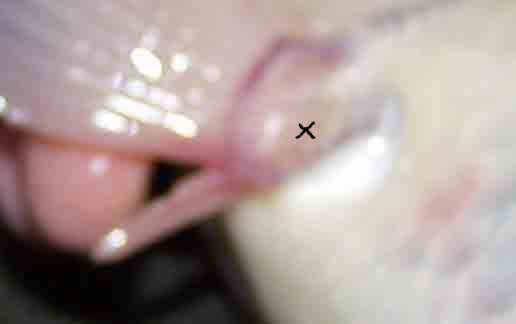
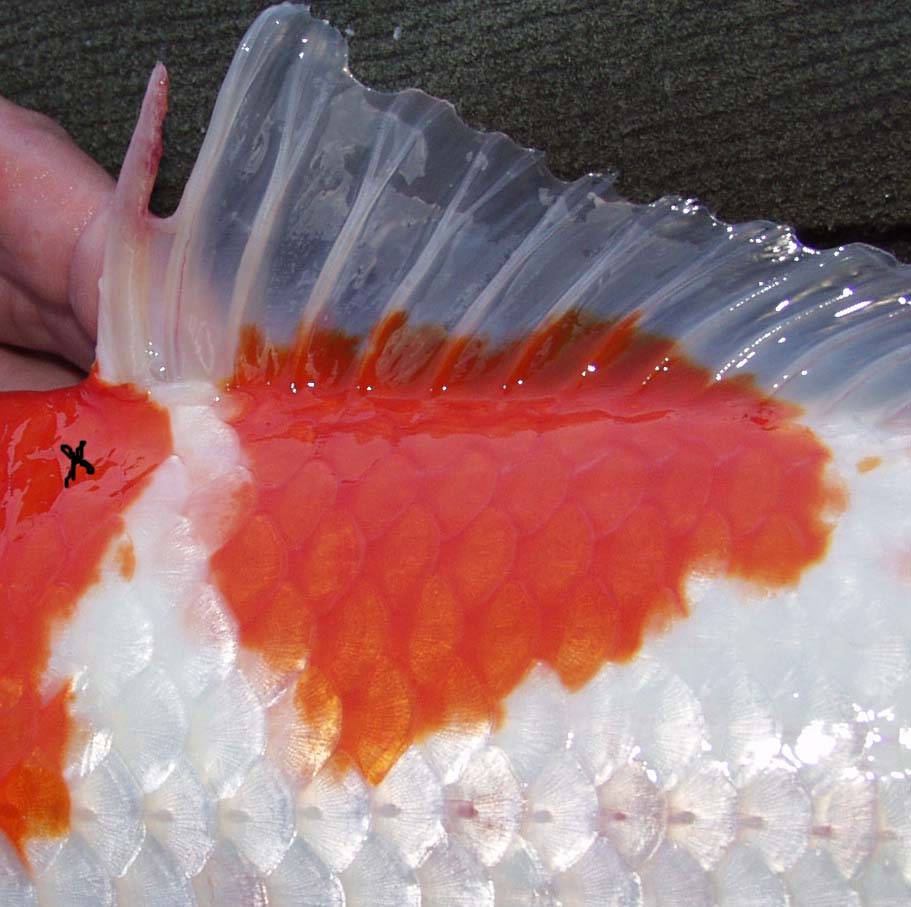
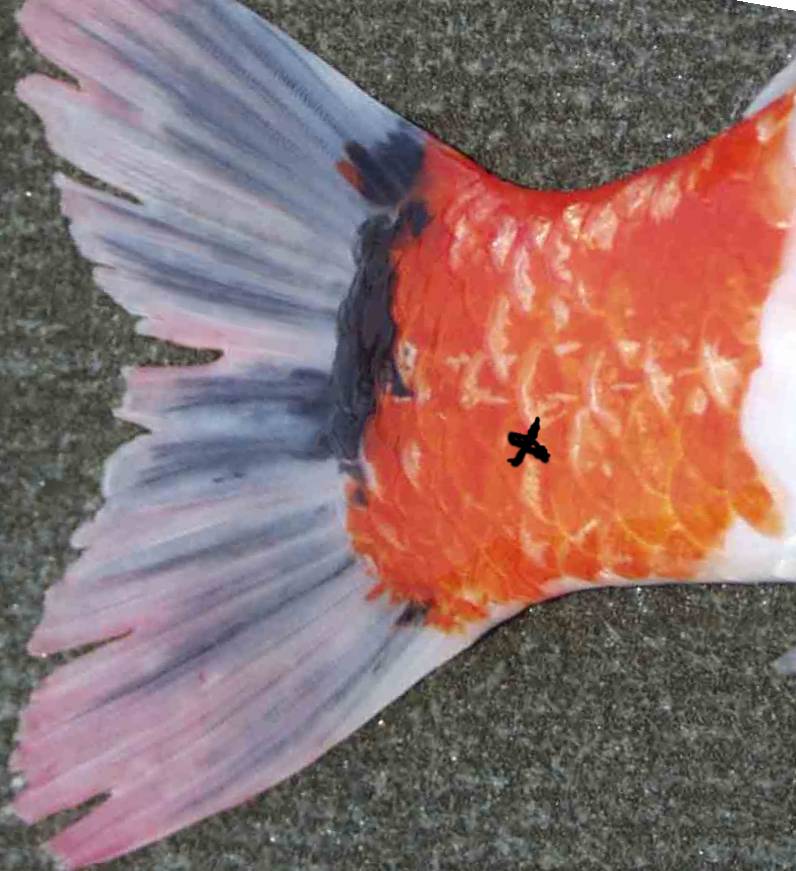
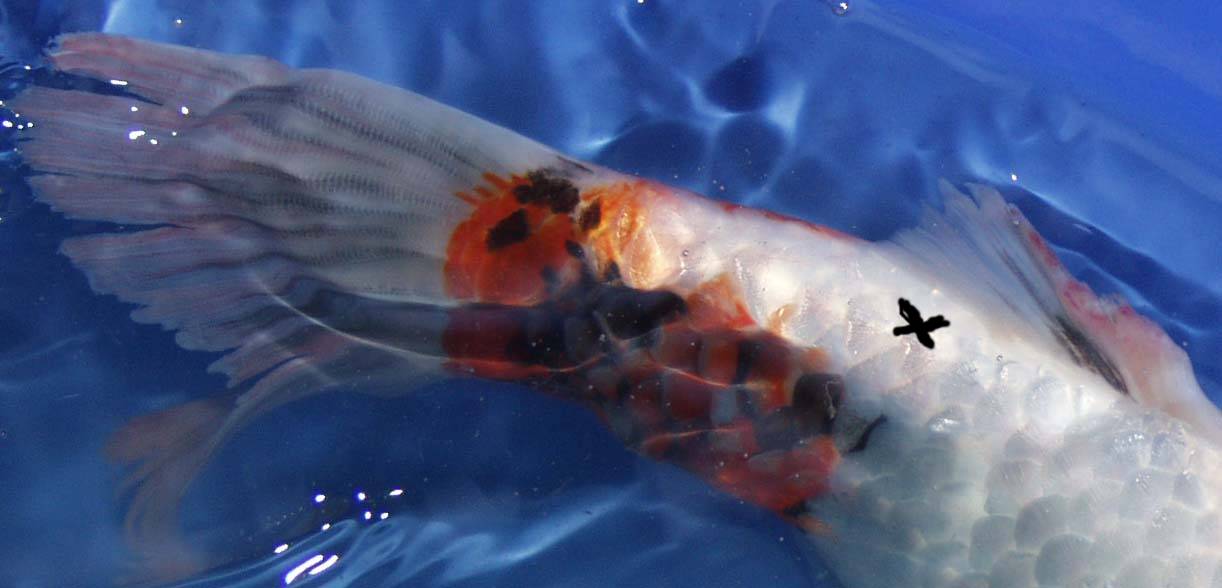

Down side
of IM injections are blow back of antibiotic out of the injection site, the
risk of infection from the injection site, plus antibiotic distribution is
generally not as good as IM
Eliminating air from the syringe
This is
a very easy technique and essential
If air find
its way into the blood stream an embolism takes place end result dead fish.
After filling
the syringe hold up the syringe vertical with the needle pointing upwards
pull back on the plunger to create space about 2/3 ml from the top of the
syringe this in effect has created an air gap at the top of the syringe, now
repeatedly flick the plastic side of the syringe with your finger nail until
the air bubbles in suspension in the antibiotic rise and burst on the surface
of the fluid. After all evidence of air in suspension has gone, whilst still
holding the needle vertical push the plunger up till the fluid rises out of
the top of the needle and no more air can be seen, job done.
conclusion
What ever
site you choose, do what you are comfortable with be it IP or IM there is
very little to choose between either when comparing the end result I.E. the
cure
- Remember to be ultra clean, cleaning
the site before and after the injection apply a sealer if possible
- Donít over do it if not sure call
a professional.
- Get some advice off your local vet
if possible, it may be that he does not know as much about fish as you do,
but he/she is well versed in antibiotics and injection techniques
- Culture and sensitivity studies can
be performed by your local vet which may save you injecting the wrong antibiotic,
or at least you will have these results coming, if your chosen antibiotic
is not working, which should place you back on track
- Sometime even antibiotics fail to
work
- Antibiotics will not effect a cure
for a virus only secondary infections
- If you place a sick injected fish
back into a bad environment it will very likely continue to get worst not
better.
†††
††††